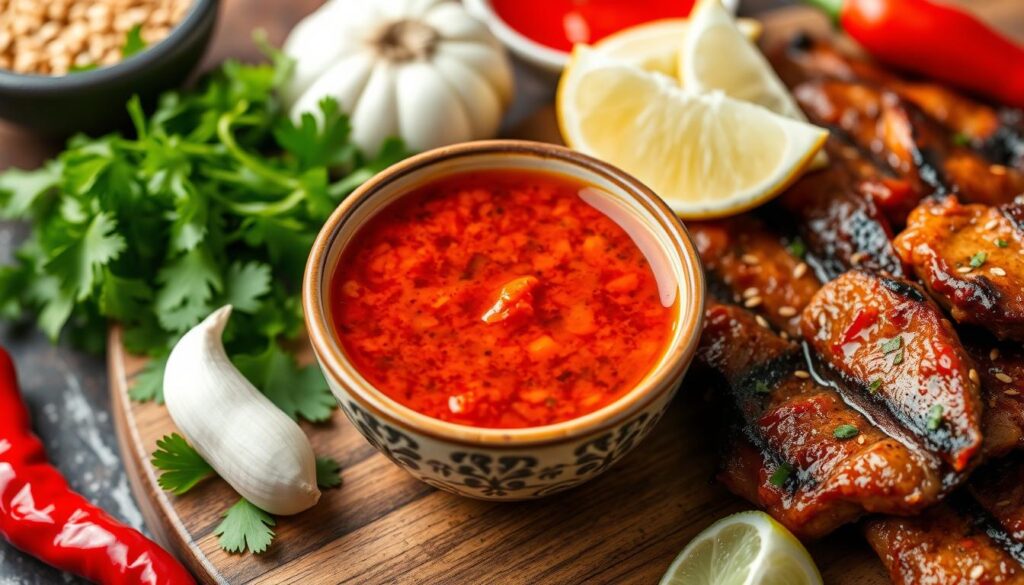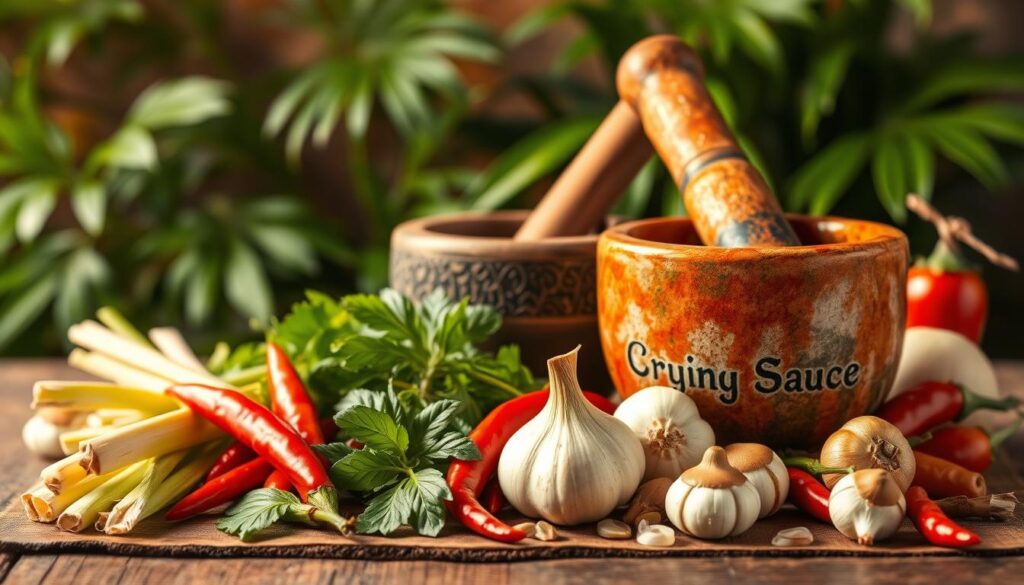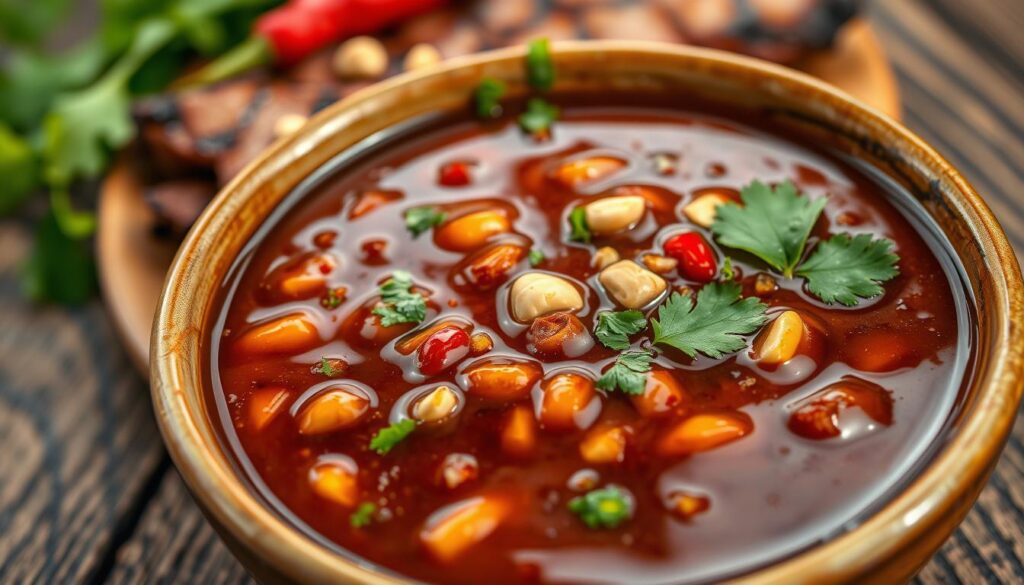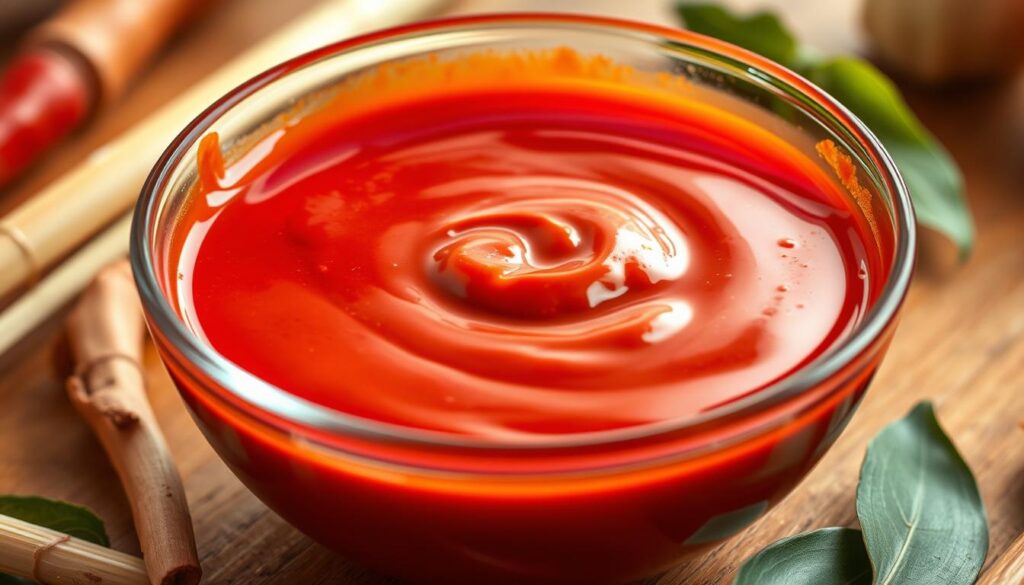Delicious Crying Tiger Sauce: Recipe & Tips
Welcome to the world of crying tiger sauce, a traditional Thai condiment. It’s known for its bold, spicy, and tangy flavor. This sauce is a staple in Thai cuisine, often served with grilled meats to boost their taste. You can bring a piece of Thailand into your kitchen with this authentic crying tiger sauce.
Table of Contents

Crying tiger sauce is a must-try for anyone who loves Thai cuisine. It has a perfect balance of spicy and sour elements. This sauce will take your grilled meats to the next level. You’ll learn how to make this spicy Thai sauce and its cultural significance in Thai cuisine.
Introduction to Crying Tiger Sauce
In this article, you’ll explore the history and recipe for crying tiger sauce. You’ll learn about the essential ingredients, how to prepare it, and how to store it. This spicy Thai sauce is a key part of Thai cuisine.
Key Takeaways
- You will learn how to make authentic crying tiger sauce at home.
- Crying tiger sauce is a traditional Thai condiment with a bold, spicy, and tangy flavor.
- This spicy Thai sauce is often served alongside grilled meats to enhance their flavor.
- You will discover the cultural significance of crying tiger sauce in Thai cuisine.
- Crying tiger sauce is a must-try for anyone who loves Thai cuisine.
- You will learn about the essential ingredients and preparation techniques for this traditional Thai condiment.
- Crying tiger sauce can be customized to suit your taste preferences.
Understanding Crying Tiger Sauce: A Thai Culinary Treasure
Crying Tiger Sauce is a hot and tangy sauce that’s key in Thai cooking. The name comes from its spicy kick that makes your eyes water. It also nods to grilling meat like a tiger, adding smoky flavor.
This thai grilled meat sauce pairs well with grilled meats. It balances flavors perfectly.
Exploring Crying Tiger Sauce reveals it’s more than a condiment. It’s a treasure that shows Thai cuisine’s heart. Its spicy and tangy taste makes it a favorite in Thai homes.

There are many versions of the sauce across Thailand. Ingredients like chilies, garlic, fish sauce, and lime juice are common. These mix to make a thai grilled meat sauce that’s spicy and sour.
It’s great as a dipping sauce for grilled meats like chicken, beef, or pork. It’s also used to marinate meats, adding rich flavor. If you love hot and tangy sauce or want to try something new, Crying Tiger Sauce is worth trying.
Essential Ingredients for Authentic Crying Tiger Sauce
To make a sauce with authentic thai flavors, you must use key ingredients. These are vital for a traditional thai condiment that’s spicy and tangy. The main ingredients are fish sauce, lime juice, chili peppers, garlic, and sometimes palm sugar.
Each ingredient is important for the sauce’s taste. Fish sauce adds umami, while lime juice brings acidity. Chili peppers make it hot, and garlic gives it a rich flavor. Palm sugar balances the flavors, making it sweet, sour, and spicy.
When mixing these ingredients, the right amounts and how they work together matter. You want a sauce that’s bold yet balanced. This way, each part enhances the others. By using these ingredients and understanding their mix, you can make a Crying Tiger Sauce that’s true to its traditional thai condiment roots and full of authentic thai flavors.

Some key points to keep in mind when selecting your ingredients include:
- Choosing a high-quality fish sauce that is rich in umami
- Using fresh lime juice for the best flavor
- Selecting the right type of chili peppers to achieve your desired level of heat
- Mincing garlic finely to release its full flavor potential
By focusing on these essential ingredients and considering their interactions, you can create a Crying Tiger Sauce that is not only delicious but also authentic and true to its traditional thai condiment heritage.
The Perfect Balance of Flavors in Thai Dipping Sauces
In Thai cuisine, getting the flavors right is key, especially in sauces like spicy thai sauce. It’s all about mixing sweetness, sourness, spiciness, and umami. This mix should enhance the dish, like how a great thai grilled meat sauce boosts grilled meats.
To get it just right, think about the sweet and sour parts. Palm sugar adds sweetness, while lime juice brings sourness. These two balance each other out. Also, controlling the heat from chili peppers is important. You want the sauce to be spicy but not too hot.
Sweet and Sour Elements
- The use of palm sugar adds a rich, sweet flavor to the sauce
- Lime juice provides a sour element, balancing out the sweetness
- The combination of these elements creates a harmonious flavor profile
Spice Level Management
The heat from chili peppers is a key part of spicy thai sauce. It’s important to adjust the spice level to please everyone. You can do this by adding more or fewer chili peppers.

Umami Components
Umami, often from fish sauce, adds depth to the sauce. It makes the sauce more than just a topping. It’s a key part of the meal, enhancing the flavor and making it rich and savory.
Step-by-Step Crying Tiger Sauce Recipe
To make crying tiger sauce, start by blending chili peppers, garlic, and a pinch of salt. Blend until it’s smooth. Then, add fish sauce, lime juice, and a bit of palm sugar if you like.
As you mix the ingredients, the sauce’s flavors will come alive. The chili peppers give it a spicy kick. The fish sauce and lime juice add a sour and salty taste. The palm sugar adds sweetness, balancing the flavors.
Here’s what you need for crying tiger sauce:
- Chili peppers
- Garlic
- Salt
- Fish sauce
- Lime juice
- Palm sugar (optional)
After blending, taste the sauce and adjust the seasoning. Add more chili peppers for heat or lime juice for tanginess. This sauce is all about personal taste, so feel free to experiment.

With this easy recipe, you can make delicious crying tiger sauce at home. It’s perfect for dipping or as a marinade. Try it out and enjoy the bold flavors of crying tiger sauce.
Customizing Your Sauce’s Heat Level
Creating the perfect hot and tangy sauce means getting the heat just right. You want a balance of flavors that enhance the authentic Thai taste. To adjust the heat, think about the chili peppers you choose.
The heat level changes with the chili pepper type. For a milder sauce, Anaheim or Poblano peppers work well. If you prefer it hotter, Ghost Peppers or Thai Bird’s Eye Chilies are better.
Choosing the Right Chilies
Here are some chili pepper options for your sauce:
- Anaheim peppers: mild to medium heat
- Poblano peppers: mild heat
- Ghost Peppers: extremely hot
- Thai Bird’s Eye Chilies: hot
Adjusting Spiciness for Different Palates
To change the sauce’s spiciness, add more or less chili peppers. You can also use sugar or fish sauce to balance the flavors. This will help achieve a true Thai taste.

Storage and Aging Tips
Storage and aging impact the sauce’s taste and heat. The sauce’s flavor and heat will soften over time. To keep the flavors and heat, store it in an airtight container in the fridge. Let it age for a few days before serving.
Best Protein Pairings for Your Sauce
Pairing proteins with Crying Tiger Sauce opens up a world of flavors. Traditionally, it’s served with grilled meats like chicken, beef, or pork. The smoky flavor of the meat pairs well with the spicy, tangy sauce. You can also try seafood like shrimp or squid, or even grilled portobello mushrooms. This makes it great for both meat-lovers and vegetarians.
Here are some top protein pairings for your popular thai dipping sauce:
- Grilled chicken: a timeless favorite
- Beef skewers: the smoky beef complements the sauce well
- Shrimp: adds a seafood twist
- Grilled portobello mushrooms: perfect for vegetarians and vegans

When pairing proteins with Crying Tiger Sauce, aim for balance. Its spicy and tangy flavors can enhance any protein. So, feel free to experiment and discover your favorite pairings for this thai grilled meat sauce.
Common Mistakes to Avoid When Making Thai Sauces
When making a traditional Thai condiment like Crying Tiger Sauce, it’s key to watch out for common mistakes. These can ruin the flavor and authenticity of the sauce. To get it right, balance the ingredients and how you prepare them. Getting the right amounts of each ingredient is crucial for the sauce’s taste.
Don’t add too much fish sauce, as it can make the sauce too salty. On the other hand, not enough chili can make it too mild. The goal is to mix sweet, sour, and spicy just right. This way, you’ll make a sauce that’s tasty and true to Thai flavors.

Other mistakes include wrong preparation steps and how you mix the ingredients. This can mess up the sauce’s texture and consistency. Also, bad storage can spoil the sauce or dull its taste. Knowing these mistakes helps you avoid them and make a great Thai sauce.
Here are some tips to keep in mind:
- Use fresh and high-quality ingredients for the best taste.
- Stick to a proven recipe to avoid trial and error.
- Keep the sauce in the fridge to prevent spoilage and let the flavors blend.
Health Benefits and Nutritional Information
Exploring spicy thai sauce reveals it’s more than just a flavor booster. It’s also packed with nutrients. The chili peppers in the sauce are full of antioxidants. These help protect cells and reduce inflammation.
The sauce also has vitamins and minerals from fish sauce, lime juice, and garlic. This makes it a great way to increase your nutrient intake.
Some key health benefits of spicy thai sauce include:
- High antioxidant content to combat cell damage
- Anti-inflammatory properties to reduce inflammation
- Rich in vitamins and minerals, such as vitamin C and calcium
Yes, spicy thai sauce has a lot of sodium from the fish sauce. But, it can still be part of a healthy diet if eaten in small amounts. Pairing it with other nutrient-rich foods lets you enjoy its taste and health perks without harming your health.

When adding spicy thai sauce to your meals, always check the ingredients. Choose versions with less sodium. With its health benefits and tasty flavor, hot and tangy sauce is a fantastic choice for anyone looking to spice up their diet.
Conclusion: Mastering Your Homemade Thai Sauce Journey
Your journey to mastering Crying Tiger Sauce is just starting. With the right ingredients and techniques, you can bring Thailand’s bold flavors to your kitchen. The secret to a great Thai dipping sauce is balance.
Find the perfect mix of sweet, sour, spicy, and umami. Don’t be afraid to try new things and make the sauce your own. By following the steps in this article, you’ll be on your way to making a Crying Tiger Sauce that will wow your friends and family.
Embrace the journey and enjoy the flavorful adventure of exploring Thailand’s rich culinary heritage. One delicious bite at a time, you’ll discover the wonders of Thai cuisine.
FAQ
What is Crying Tiger Sauce?
Crying Tiger Sauce is a spicy Thai condiment. It’s known for its bold, tangy flavor. People often use it as a dipping sauce for grilled meats.
What are the key ingredients in Crying Tiger Sauce?
The main ingredients are fish sauce, lime juice, and chili peppers. Garlic and sometimes palm sugar are added too. These mix together to create its unique taste.
How do I adjust the heat level of Crying Tiger Sauce?
You can change the sauce’s heat by choosing different chili peppers. For a milder taste, use Anaheim or Poblano peppers. For a spicier sauce, try Thai Bird’s Eye Chilies or Ghost Peppers.
What are the best proteins to pair with Crying Tiger Sauce?
Traditionally, it goes well with grilled chicken, beef, or pork. But it also pairs well with seafood and vegetables. This makes it a great sauce for many dishes.
What are some common mistakes to avoid when making Thai sauces like Crying Tiger Sauce?
Avoid using the wrong ingredient amounts and not preparing it right. Also, don’t store it wrong. Getting the flavors right and storing it properly are key for a true taste.
What are the health benefits of Crying Tiger Sauce?
The sauce is full of antioxidants from chili peppers. It also has vitamins and minerals. Though it’s high in sodium, it can be part of a healthy diet if eaten in small amounts.

